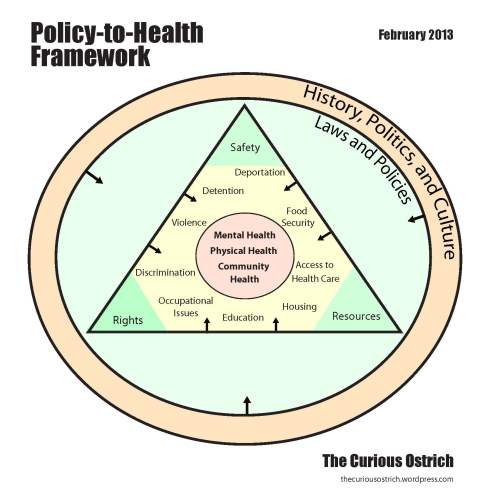The fate of immigration reform legislation this year remains uncertain (See below for more information). What is certain, however, is that immigration policy, in its current and future forms, will always have a tremendous impact on the rights, resources, and safety, and, ultimately, the health of immigrants in the United States. Public health professionals and immigrants rights activists will have to make critical assessments of how existing and proposed policies may protect or harm the health of our nation’s immigrants. Knowledge is needed for these efforts. However, there is very little information about how immigration policies affect public health.
The Curious Ostrich’s Immigration-to-Health Policy Framework lays out the many ways in which policies may impact immigrant communities. We now offer our readers the Undocu-Bibliography, a collection of articles in the public health literature that consider the social environment faced by undocumented individuals – from access to health care to stigma and stress. The bibliography was compiled through searches on Pubmed, a free database of biomedical research run by the United States National Library of Medicine. We ran queries for articles on undocumented individuals that explicitly consider immigration legal status and how it affects well-being. This means that this bibliography focuses on studies that have conducted some form of analysis to assess the connections between immigration legal status and health. Studies of undocumented individuals that gave only brief mention to the factors that impact lives of undocumented peoples were not included.
 The Undocu-Bibliography reflects the current focus of public health research on undocumented individuals: the majority of articles focus on access to health care issues. While an important factor in health, it is but a small contributor to the collection of factors that can affect people’s health. Worth reading are articles highlighted in yellow that provide a deeper analysis of social and political factors that play a large role in the health of undocumented people.
The Undocu-Bibliography reflects the current focus of public health research on undocumented individuals: the majority of articles focus on access to health care issues. While an important factor in health, it is but a small contributor to the collection of factors that can affect people’s health. Worth reading are articles highlighted in yellow that provide a deeper analysis of social and political factors that play a large role in the health of undocumented people.
This living, working, evolving document will include a compilation of academic public health studies that consider undocumentedness. Our goal is to create a resource that is useful for researchers and advocates. In the long term, we hope to create a record of the important research in this area and support further work in this area. We encourage readers to send us suggested additions to this bibliography. If you are interested in learning more about where we found these articles and how we selected them, please check out our methods. If you need assistance viewing and using this bibliography, please contact us at ostrichblog@gmail.com.
News update: Immigrant rights activists rally Oct 5th
Action on immigration reform may happen yet! Immigrant activists all over the country rallied on Saturday, October 5th in 90 events at cities across the nation to demand legislation this year. The biggest event took place on the National Mall in Washington, D.C., the iconic site of so many important civil rights struggles. The National Park Service, technically on furlough because of the shut-down, opened up the Mall in the name of First Amendment rights to allow thousands of marchers to take the public space and demand “respect for our hard work and for the many contributions we make to the nation’s culture, economy, communities, and faith.” Similar marchers and rallies took place from Fresno, CA to the Twin Cities.
While action is stalled at the National level, California has been leading the way in passing state-level pro-immigration legislation. The New York Times Editorial page has hailed this series of laws as a model for states to enact positive legislation in the context of federal inaction. Among the bills signed this month by Gov. Jerry Brown, was a bill for drivers licenses for all in California and the TRUST Act, which would prevent cooperation with ICE in some circumstances.



